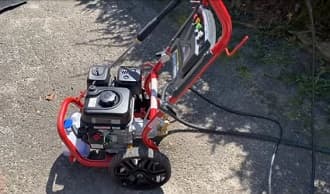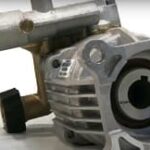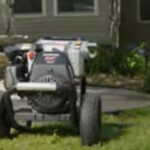As an Amazon Associate, this site earns commissions from qualifying purchases. For more information click here.
Have you ever had a pressure washer that refuses to start with water on? You checked the water supply and it is sufficient, but the engine just refuses to run. This can be a real nuisance if you have a lot of cleaning to do. This article will point out the most common reasons why this can happen and how to fix it.
If your pressure washer won’t run with the water on, it probably has a damaged water pump or clogged carburetor. It could also be due to a clogged fuel filter, a dirty spark plug or an overheated engine.
Let us look at the other possible causes in detail and the right way to troubleshoot them.
Fuel Pump Malfunction
The fuel pump is responsible for moving fuel from the tank into the combustion chamber. If the pump is clogged, dirty or broken, there will be no fuel available for the engine. If there is limited fuel available, the pressure washer will not run even with water available. This type of problem can also happen if your pressure washer only runs on choke.
How to Fix
It depends on the fuel pump status. If the pump is damaged, it must be replaced. If it is just dirty, cleaning may be enough. Remove the fuel pump and perform a thorough inspection. An old pump may be covered with rust or fuel sludge already. Try cleaning but if that does not work, replacement is a must.
There are a lot of cleaning solutions for pressure washer pumps available including the STA-BIL Pump Protector. Pick one that is compatible with your machine and give it a try. If the pressure washer is still new and there is no structural damage, this should work.
Dirty Fuel Filter
A gas pressure washer depends on the fuel filter to keep it running smoothly. The filter acts as a screen that keeps dirt away from the fuel. Clean, fresh fuel makes it easy for a pressure washer to run and perform its tasks.
If the filter gets clogged with dirt, it contaminates the fuel that goes into the combustion chamber. This will affect the mixture and prevent it from burning properly. The engine might still run but certain functions won’t work. This could prevent the pressure washer from running even when there is ample PSI and GPM.
How to Fix
Check the fuel filter for signs of damage or dirt. Sometimes a fuel filter gets so dirty it is hard to see the damage. In any event, fuel filters are usually for one time use only. There are exceptions: if the owner’s manual says the fuel filter is reusable, clean it and try again.
If the manual does not say anything, assume that the fuel filter is for single use only. Replace the fuel filter and make sure the replacement is compatible with the engine. Install the new filter and the machine should run.
Check the Water Supply
If the pressure washer looks fine, check the water supply. If there is clogging, lack of pressure or low water volume, no water will come out of the nozzle. It might seem like there is a problem with the pressure washer but in fact it is due to the water supply.
A pressure washer is powered by a gas powered engine or an electric motor. The water pump pulls the detergent and water together, combines them, and releases it through the hose.
How to Fix
If your pressure washer cannot run with the water on, there could be something wrong with the pump. First double check the water supply to ensure there is enough. Second, perform a visual inspection of the pump. Sometimes a cleaning is all that is needed. If the pump is damaged however it must be replaced.

Defective Spark Plug
All small engines use a spark plug to produce the spark that sets the engine running. Just like with other engine parts, dirt and damage can cause problems. But how does this affect the pressure washer’s ability to run with or without water?
If the plug cannot generate a spark, the engine will not start. Without any power the pressure washer cannot run. Even if you have ample water pressure and supply, nothing is going to work because the spark plug is defective.
How to Fix
Use a spark plug tester to check if it is still working. We recommend the LinkStyle tester as it is fast and accurate.
If the plug is functional, it should emit a spark on its tip. If there is no spark, the spark plug is damaged and must be replaced. The rule of thumb is you should install a new spark plug every 12 months.
Damaged Ignition Coil
The spark that the spark plug generates comes from the ignition coil. So if the ignition coil is not working the engine will not run.
If you replaced the spark plug but nothing works, check the ignition coil. There are a number of things that can affect it, and how you respond depends on the problem.
How to Fix
- Turn off the pressure washer and check the ignition coil
- Check for loose wires and connectors. It is possible that some connections got loose as you used the pressure washer. Restore these connections and tighten the existing ones.
- The terminal pins might be broken or bent. Without these pins there is no way for the ignition coil to transmit sparks to the spark plug. You might be able to replace it, though in other cases you have to replace the ignition coil entirely.
- Water moisture is another reason why ignition coils fail. If there is water or moisture the ignition coil has to be replaced. You can also use an ignition tester to verify if the component is working or not.
Carburetor Problems
The carburetor supplies air to the engine so it can ignite the fuel. The proper air and fuel mix is essential for a pressure washer to run.
If the carburetor is damaged or clogged, it won’t be able to supply the air required by the combustion engine. Because of the way carburetors work, it tends to get covered with fuel sludge. This is particularly true if the liquid is not replaced every 30 days.
How to Fix
Usually the carburetor is installed behind an air filter. Remove the air filter and you will see the carburetor. With luck the filter absorbed most of the sludge.
Clean the filter first. If the carburetor is covered with gummy oil, remove it from its casing. Use a cleaning solution to remove the sludge. Put the carburetor back on after cleaning.
If the carburetor has been damaged it has to be replaced. Install the new one and turn on the pressure washer on.
Old Fuel
A lot of the gunk on small engines come from old fuel turned gummy. This is what happens when gas is not replenished every four weeks. The fuel turns a darker color, thicker texture and can no longer be used.
How to Fix
The solution is simple. Replace the fuel every 30 days. If you are not going to use the pressure washer for several weeks, empty the reservoir. This is the best way to prevent sludge from clogging the engine. This rule about replacing old fuel also applies to lawn mowers, chainsaws, hedge trimmers and other outdoor tools.
Overheated Engine
This is a very common problem with pressure washers during the summer. Its engine generates heat when it runs, and at some point it will overheat. When that happens the pressure washer might stall and some functions will not work.
How to Fix
Let the engine cool down. Usually it only takes a few minutes but could take longer depending on the temperature. After the pressure washer has cooled off, try running it again with water on. If it still refuses to run, there might be a problem with the carburetor or other engine parts.

I love the outdoors and all the tools for maintaining gardens, yards and lawns. The only thing I am more passionate about is sharing what I know about garden and outdoor equipment.


